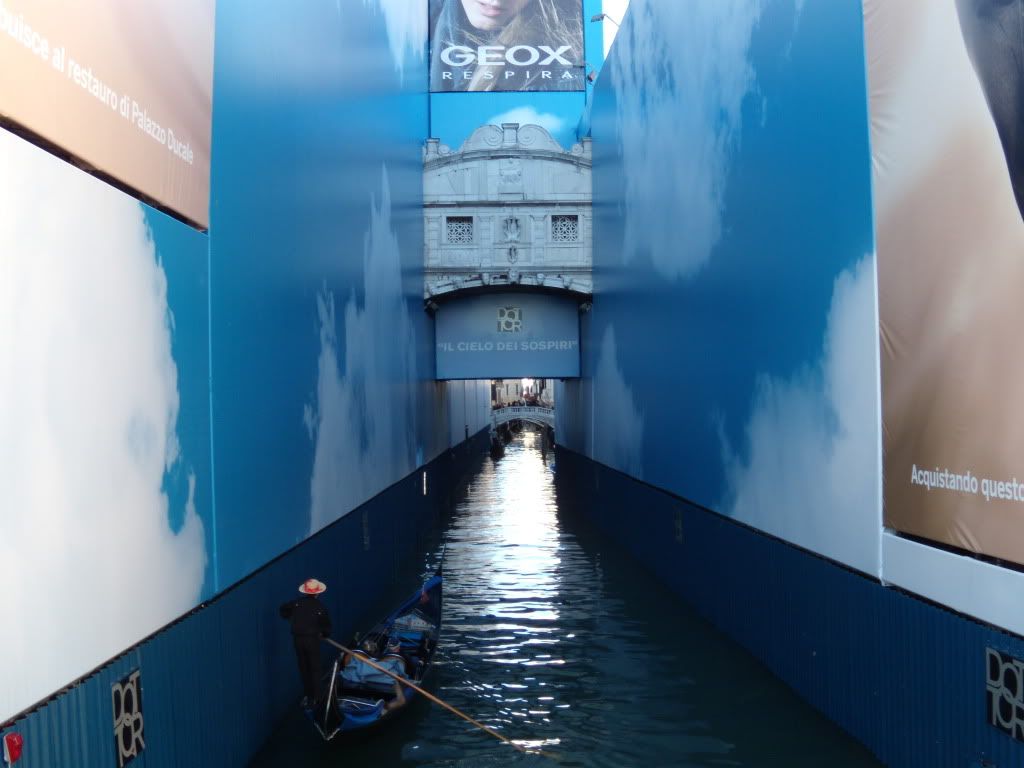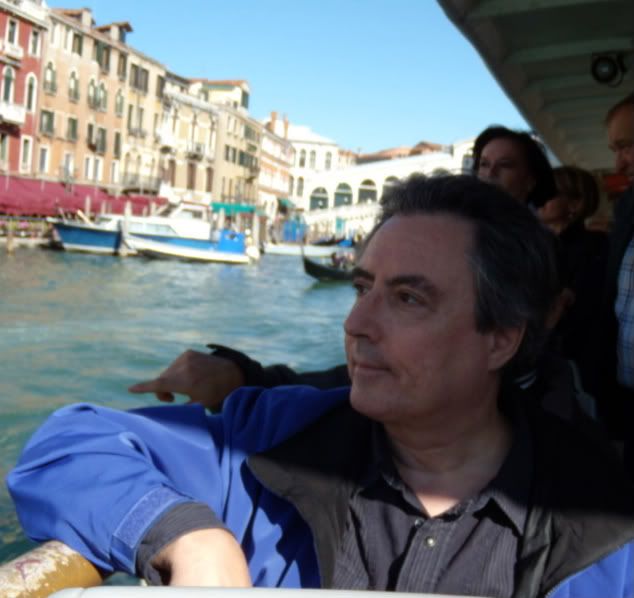You emerge from the vaporetto near Piazza San Marco and head toward the world's most famous piazza, the "drawing room of Europe," with its sophisticated cafes where aristocrats and artists and visitors have admired the view and checked out one another for centuries. If you haven't been to Venice in a long time (it was 30 years in my case), shock sets in. The pavement from the boat landing to the piazza is lined end to end with cheap-jack souvenir stalls of the sort you see in the aisles of shopping malls, peddling gadgets and tatty jewelry.
Nor does it end there; the coffee mug and T-shirt stands spill over into the space between the Grand Canal and the Piazza, beside the magnificent Doges' palace. Aside from their revolting contrast with the world-famous architecture, the shoddy, circus-like sales booths impede the movement of the vast numbers of people thronging the city's center, causing more congestion.
At the other end of the commercial scale, big business — mainly expensive fashion — has gotten into the act. At any given time, some of the buildings in Venice are covered with scaffolding for repairs, annoying but necessary for preservation. These days, though, the scaffolding is hung with huge banner advertisements. The medieval streets and canals, the church towers shrink to secondary roles next to giant pitches for models in their underwear.
Below is a shot I took of the famous Bridge of Sighs, where convicts were led from the court in the Doges' Palace to the prison next door and sighed as they got their last look at the city and its lagoon.

On the left is a wall of the Doges' Palace; to the right is the former prison; that bit in the top center is the bridge. At the moment, it serves as a commercial for Geox, whatever that is.
True, the ads on the restoration sites are temporary, but when the work is done, others like them will appear on different sites undergoing repair.
And it's also true that this commercial rape isn't everywhere in Venice, you can get away from it, it's only in the popular tourist spots. But while much of the city's interest lies in out-of-the-way neighborhoods, the fact is that the end-to-end souvenir shops and garish ads deface the areas that have been Venice's heart and soul for hundreds of years: not only the Piazza of San Marco, but such traditional strolling paths as the Riva degli Schiavoni and the Zattere on Dorsoduro, across the canal from San Marco.
Oh, and the graffiti. You see more graffiti in European cities then anywhere in the U.S. except the worst, half-abandoned neighborhoods. In Venice, walls (including those of churches) and bridges (including the famous Rialto) have been "tagged" like a New York subway car in 1980. Practically the only buildings I saw not defaced by graffiti were the offices of the Questura (local police). It is unimaginable that any city in the United States today would allow its treasured monuments to be marked like tatooed New Guinea natives. But Europeans are so much more tolerant and open-minded, so understanding of the need for young artists to express their creativity, than we uptight Yanks.
In the past, Venetians were fiercely proud of their city, as they had every right to be. When its independence was lost after 800 years in 1797 to the Austrians and later to the French, they were devastated. Later they fought, and some lost their lives, to get it back. What does it say about the present city politicians that they have allowed their city to be turned into a combination of Disney World, thrift store, and bridge underpass?
Most of the relatively few Venetian residents who remain are probably disgusted with the state of things, but Italy is not a place where you fight city hall. One consolation is that all the conditions I have mentioned could be reversed some day if politics or values change.
This is certainly not meant to discourage anyone from going to Venice. It's still a city of artistic and architectural marvels, and despite my disappointment at some aspects of it, I'm thankful for having been privileged to visit again.
True, the ads on the restoration sites are temporary, but when the work is done, others like them will appear on different sites undergoing repair.
And it's also true that this commercial rape isn't everywhere in Venice, you can get away from it, it's only in the popular tourist spots. But while much of the city's interest lies in out-of-the-way neighborhoods, the fact is that the end-to-end souvenir shops and garish ads deface the areas that have been Venice's heart and soul for hundreds of years: not only the Piazza of San Marco, but such traditional strolling paths as the Riva degli Schiavoni and the Zattere on Dorsoduro, across the canal from San Marco.
Oh, and the graffiti. You see more graffiti in European cities then anywhere in the U.S. except the worst, half-abandoned neighborhoods. In Venice, walls (including those of churches) and bridges (including the famous Rialto) have been "tagged" like a New York subway car in 1980. Practically the only buildings I saw not defaced by graffiti were the offices of the Questura (local police). It is unimaginable that any city in the United States today would allow its treasured monuments to be marked like tatooed New Guinea natives. But Europeans are so much more tolerant and open-minded, so understanding of the need for young artists to express their creativity, than we uptight Yanks.
In the past, Venetians were fiercely proud of their city, as they had every right to be. When its independence was lost after 800 years in 1797 to the Austrians and later to the French, they were devastated. Later they fought, and some lost their lives, to get it back. What does it say about the present city politicians that they have allowed their city to be turned into a combination of Disney World, thrift store, and bridge underpass?
Most of the relatively few Venetian residents who remain are probably disgusted with the state of things, but Italy is not a place where you fight city hall. One consolation is that all the conditions I have mentioned could be reversed some day if politics or values change.
This is certainly not meant to discourage anyone from going to Venice. It's still a city of artistic and architectural marvels, and despite my disappointment at some aspects of it, I'm thankful for having been privileged to visit again.



3 comments:
Rick: I just discovered your blog through your comment at Mangan's. It seems that we have a lot of the same interests and viewpoints - especially about politics and spirituality. I just bookmarked your site, and I'm going to read some of your articles as time permits.
If you're interested, I have a blog of my own.
http://mustardseednovel.blogspot.com/
Take care,
Todd White
I heard similar tales of Venice from a Scandinavian friend who had visited there a few years ago. But she reported even worse things than you do, such as large numbers of Roma "immigrants" using the streets as public toilets. And yeah the graffiti in Europe is unbelievable; I even saw it on marble statues at Versailles, and that was in the 70s.
Todd,
Thank you, I will visit your blog.
MaryJ,
It sometimes seems that Europeans actually welcome the defacement of their historic buildings, they are so contemptuous of their own cultural tradition.
Post a Comment